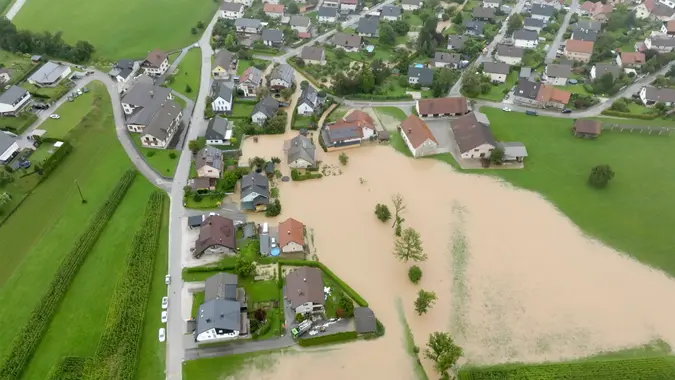11 Cities Retirees May Want To Avoid Moving To Due To Rise in ‘Extreme Weather Events’

Commitment to Our Readers
GOBankingRates' editorial team is committed to bringing you unbiased reviews and information. We use data-driven methodologies to evaluate financial products and services - our reviews and ratings are not influenced by advertisers. You can read more about our editorial guidelines and our products and services review methodology.

20 Years
Helping You Live Richer

Reviewed
by Experts

Trusted by
Millions of Readers
Pick a place, any place, in the U.S. to retire — and forget, for a moment, that the cost of living matters. Think solely of the attributes of the place. You probably want somewhere relaxed, somewhere beautiful and somewhere with mild winters. But wait, you may want to rethink that last aspect.
Now that the repercussions of climate change are being severely felt in the U.S., largely in the form of warmer temperatures, some cities are experiencing an uptick in “extreme weather events,” including flooding, which can destroy your home — or worse.
Last year, AARP released their list of the 11 U.S. retirement hotspots where the effects of climate change are a growing threat according to the following criteria: the city’s extreme heat threshold, its extreme heat days per year, its average annual costs due to flooding and its extreme heat days per year. Keep reading to find out which cities you should reconsider making your retirement destination.
10. Provo, Utah
- Extreme heat threshold: 93°
- Extreme heat days per year compared to 1970 (13 days or more): 15 more
- Average annual flood loss: $7.4 million
- Projected increase in flood loss, 2050: 3.8%
10. Dallas-Fort Worth (Tied With Provo)
- Extreme heat threshold: 99°
- Extreme heat days per year compared to 1970 (13 days or more): 14 more
- Average annual flood loss: $78.4 million
- Projected increase in flood loss, 2050: 5.5%
9. Durham, North Carolina
- Extreme heat threshold: 91°
- Extreme heat days per year compared to 1970 (13 days or more): 34 more
- Average annual flood loss: $5.4 million
- Projected increase in flood loss, 2050: 13.3%
8. Houston
- Extreme heat threshold: 97°
- Extreme heat days per year compared to 1970 (13 days or more): 33 more
- Average annual flood loss: $145.8 million
- Projected increase in flood loss, 2050: 52.0%
7. Charleston, South Carolina
- Extreme heat threshold: 92°
- Extreme heat days per year compared to 1970 (13 days or more): 14 more
- Average annual flood loss: $156.2 million
- Projected increase in flood loss, 2050: 100.4%
6. Boise, Idaho
- Extreme heat threshold: 92°
- Extreme heat days per year compared to 1970 (13 days or more): 23 more
- Average annual flood loss: $22.9 million
- Projected increase in flood loss, 2050: 24.7%
5. Austin, Texas
- Extreme heat threshold: 101°
- Extreme heat days per year compared to 1970 (13 days or more): 28 more
- Average annual flood loss: $36.6 million
- Projected increase in flood loss, 2050: 8.4%
4. College Station, Texas
- Extreme heat threshold: 99°
- Extreme heat days per year compared to 1970 (13 days or more): 24 more
- Average annual flood loss: $4.3 million
- Projected increase in flood loss, 2050: 5.8%
3. Raleigh, North Carolina
- Extreme heat threshold: 91°
- Extreme heat days per year compared to 1970 (13 days or more): 34 more
- Average annual flood loss: $5.4 million
- Projected increase in flood loss, 2050: 13.3%
2. Wilmington, North Carolina
- Extreme heat threshold: 90°
- Extreme heat days per year compared to 1970 (13 days or more): 5 more
- Average annual flood loss: $21.7 million
- Projected increase in flood loss, 2050: 68.5%
1. Myrtle Beach, South Carolina
- Extreme heat threshold: 91°
- Extreme heat days per year compared to 1970 (13 days or more): 18 less
- Average annual flood loss: $39.9 million
- Projected increase in flood loss, 2050: 58.8%
 Written by
Written by  Edited by
Edited by 

























